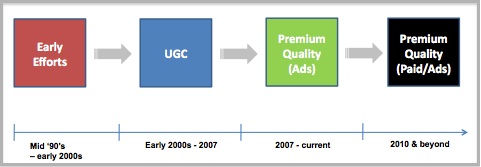-
Putting Premium Content Within an Arm's Length of Desire
Robert Woodruff, the long-time president of Coca-Cola, had a famous quote summing up his ambition for the fizzy brown water: "I want Coke to be within an arm's length of desire." Given the initiatives of Apple, Google, Netflix, Hulu, Amazon, Sony, pay-TV operators, Roku, TiVo, gaming consoles and numerous others, a spin on the Woodruff quote might well be, "They're all putting premium content within an arm's length of desire." It's no exaggeration to say that we are on the cusp of unprecedented consumer access to premium content - both current and past seasons' TV programs along with archived and new-release movies.
The choices being presented to consumers are dizzying, and are poised to become increasingly complex. With Apple's announcement yesterday of a $99 Apple TV connected device, and 99-cent rentals from ABC and Fox (and others no doubt to follow), another relatively low-cost option for viewing premium content will be available. Not to be outdone, Amazon also unveiled its own 99-cent option yesterday, for downloads of TV programs, though the durability of this offer isn't yet clear. And Sony too announced a new service called Qriocity to delivery its content to its connected devices.
All of these follow other important 2010 initiatives that make premium content more accessible, such as Hulu Plus, the iPad and its hugely popular Netflix and ABC.com apps, Google TV, Samsung Apps, TV Everywhere and others. Add them all up and soon enough most Americans will have at least one device in their home that gives them online access to premium content delivered to their TVs. In fact, many already have at least one device, and some have 2 or more. On top of high-quality access, bonus features like Apple's AirPlay, which allows multiple devices to hand-off content to each other for seamless viewing experiences, will also soon become the norm.
Online delivery of premium video has been around for over 10 years, going back to early efforts from RealNetworks. But it's really only within the last 5 years that the momentum has picked up. I've been showing the below graph in presentations I've shared for the last year or so. Real's early efforts morphed into the user-generated content craze epitomized by YouTube. Subsequently, Hulu and the broadcast TV network sites began to bring premium content online supported by advertising. But given the limitations of the ad-only model, what we've been seeing in 2010 is an important shift to paid-only and hybrid pay-ad supported models. We can expect this to continue into 2011.
The result of all this activity is that consumers will have premium content available within an arm's length of desire like never before. Inevitably that means consumption is going to rise and business models are going to flex further to accommodate even better/cheaper/faster access. Those that don't play by the rules of this new game will be increasingly marginalized as consumers make their choices based on price, quality and convenience. Far from being usurped by amateur content, the same omnipresence that made Coke a powerhouse is going to create significant momentum for premium quality content.
What do you think? Post a comment now (no sign-in required).Categories: Aggregators
Topics: Amazon, Apple, Netflix, Sony

